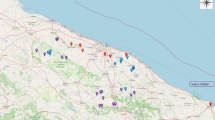Abstract
In order to assess the existence of autochthonous strongyloïdiasis, a retrospective study was carried out in Région Midi-Pyrénées (Southwestern France). Among 63 strongyloïdiasis cases diagnosed at the Consultation of the Department of Parasitology, CHU Purpan in Toulouse, 17 patients (27%) were identified as likely harboring an autochthonous infection. The diagnosis was based upon the results of either Baermann's method for stool examination, or indirect fluoroimmunoassay using Strongyloïdiasis ratti L3 larvae as antigen. Repeated contact with soil or mud, due to occupation or gardening, was found in 13 patients. Twelve cases lived in the upper basin of the Garonne River. The clinical and laboratory findings were similar to those reported by the literature. No case of larva currens was observed. These results suggest that a permanent transmission of strongyloïdiasis possibly exists in Région Midi-Pyrénées, requiring further prospective studies.
Similar content being viewed by others
References
Scaglia M, Brustia B, Gatti S, et al. Autochthonous strongyloïdiasis in Italy: An epidemiological and clinical review of 150 cases. Bull Soc Pathol Exot 1984; 77: 328–332.
Cremades Romero MJ, Igual Adell R, Ricart Olmos C, et al. Infection por Strongyloïdes stercoralis en la comarca de La Safor (Comunidad Valenciana). Med Clin (Barc) 1997; 109: 212–215.
Grove DI, Blair AJ. Diagnosis of human strongyloïdiasis by immunofluorescence using Strongyloïdes ratti and Strongyloïdes stercoralis larvae. Am J Trop Med Hyg 1981; 30: 344–349.
Pawloski ZS. Epidemiology, prevention and control. In: Grove DI (ed), Strongyloïdiasis. A major round-worm infection of Man. London: Taylor and Francis, 1989: 233–249.
Junod C. Etude rétrospective de 1934 cas de strong-yloïdose diagnostiqués à Paris. Bull Soc Pathol Exot 1987; 80: 357–382.
Poirriez J, Becquet R, Dutoit E, et al. Anguillulose autochtone dans le nord de la France. Bull Soc Pathol Exot 1992; 85: 292–295.
Grove DI. Clinical manifestations. In: Grove DI (ed), Strongyloïdiasis. A major roundworm infection of Man. London: Taylor and Francis, 1989: 155–173.
Johansson SGO, Mellbin T, Vahlquist B. Immunoglobulin levels in Ethiopian pre-schoolchildren with special reference to high concentrations of immunoglobulin E. Lancet 1968; i: 1118–1121.
Bezjak B. Immunoglobulin studies in strongyloïdiasis with special reference to raised serum IgE levels. Am J Trop Med Hyg 1975; 24: 945–948.
Cremades Romero MJ, Pellicer C, Menendez, et al. Infeccion por Strongyloïdes stercoralis en pacientes con patologia bronquial obstructiva. Arch Bronconeumol 1997; 33: 384–388.
Neva FA, Filho JO, Gam AA, Thompson R, Freitas V, Melo A, Carvalho EM. Interferon-gamma and interleukin-4 responses in relation to serum IgE levels in persons infected with human T lymphotropic virus type I and Strongyloïdes stercoralis. J Infect Dis 1998; 178: 1856–1859.
Gill GV, Bell DR, Fifleld R. Lack of IgE response to longstanding strongyloïdiasis. Clin Exp Immunol 1979; 37: 292–294.
Basset D, Guyonnet JP, Bastien P, et al. Foyer endémique d'anguillulose autochtone dans un camp de gitans de l'Hérault. Bull Epidémiol Hebd 1994; 24: 109.
Braun TI, Fekete T, Lynch A. Strongyloïdiasis in an institution for mentally retarded adults. Arch Int Med 1988; 148: 634–636.
Magnaval J-F, Baixench M-T. Toxocariasis in the Midi-Pyrénées region. In: Lewis JW, Maizels RD (eds), Toxocara and toxocariasis. Clinical, epidemiological, and molecular perspectives. London: Institute of Biology and British Society for Parasitololgy, 1993: 83–87.
Brigden M, Graydon C. Eosinophilia detected by automated blood cell counting in ambulatory North American outpatients. Arch Pathol Lab Med 1997; 121: 963–967.
Author information
Authors and Affiliations
Rights and permissions
About this article
Cite this article
Magnaval, JF., Mansuy, JM., Villeneuve, L. et al. A retrospective study of autochthonous strongyloïdiasis in Région Midi-Pyrénées (Southwestern France). Eur J Epidemiol 16, 179–182 (2000). https://doi.org/10.1023/A:1007632028471
Issue Date:
DOI: https://doi.org/10.1023/A:1007632028471




